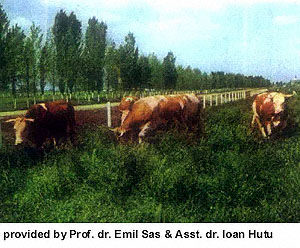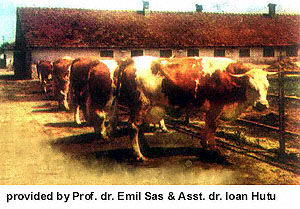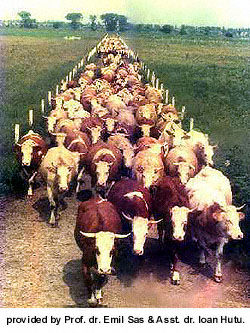
Since 1860, the Baltana Romaneasca, also known as Romanian Spotted Cattle, breed has been formed as the result of a long crossing between the Grey Romanian Cattle native breed cows with Simmental bulls imported from Switzerland, Austria, Germany, Czech Republic and Slovakia. The historical provinces that offered the best breeding conditions were: Banat, Transylvania and Bucovina. Nowadays the Romanian Spotted Cattle is the most numerous breed in Romania.

The most significant imports of Simmental bulls and heifers as well, were made especially in Romanian areas with German inhabitants, between 1860-1872, 1885-1890 and 1919.
The first breeding associations were founded in 1910; milk production control was introduced in 1914. Between 1962-1980, 1400 Simmental heifers and 60 Simmental bulls were imported.
The import of frozen semen from progeny-tested bulls started in 1976; several hundred thousands frozen semen doses have been imported.
The main lines of the breed have been founded, in chronological order, by: Ideal 470, Trotz 2061, Roland 214, Kurt, Milano, Waechter, Hector, Waldemar, Agakan, Salamon, Polder, Kapital, Herold, Piltz, Benito, Saulus, Herman, Homar, Stan, Patron.
The effect of this long absorption was the establishment of a population resembling the Simmental breed, but preserving some own traits in the same time. Called Romanian Spotted Cattle, it was established as a breed in 1959. It is phylogenetically related to the following breeds: Simmental, Fleckvieh, Montbéliarde, Czech and Slovakian Spotted Cattle, Hungarian Spotted Cattle, Sychev (Russia).
The Romanian Spotted Cattle has spread quickly due to its qualities so that it represented 37% from the Romanian cattle stock in 1955 and 44% in 1969. Nowadays, it represents 36% due to the establishment of a new breed, Black Spotted Romanian Cattle, which has partially inhabited the initial area of the Romanian Spotted Cattle.

The Romanian Spotted Cattle is still characterized by a high variability due to:
the variability of the maternal breed (Romanian grey cattle-with five zonal types):
the polymorphism of the Simmental breed which is due to morphological type differences from origin countries;
the changing, in time, of the objects in differentiated improvement of Simmental Cattle's main productive abilities.
The medium values of main morphometrical parameters of the Romanian Spotted Cattle are the following:
|
Specification |
Cows |
Bulls |
|
Withers-height |
133 cm |
150 cm |
|
Bodyweight |
600 kg |
900 kg |
|
Heart girth |
186 cm |
220 cm |
Although the variability has been restricted for the past twenty years, three basic types can still be found at present:
|
Type |
Withers height - cm |
Weight - kg |
|
The Banat plain type |
136 |
650 |
|
The Tansylvania and Bucovina type |
134 |
600 |
|
The Banat and Crishana hill type |
132 |
550 |
Its color is red with white (with shades from brick red to chestnut), yellow with white (varying from light yellow, sand to wheat yellow ochre). Its head, limbs down the hocks and knees, the lower barrel, the udder, the brisket, the medium and inferior third of the tail are white. The muzzle is pink, the horns and hoops are yellow.
The occurrence of some pigmented zones on the head, limbs and barrel are not breed impurities, these must be considered as resulting from the Romanian Grey as maternal breed.
The Romanian Spotted Cattle is hipermetrical with mesomorph morphological type, having the ratio between oblique trunk length and withers height 119-120%. General speaking the conformation is mediocre from the harmony point of view, the sturdy build is highly spread. The head is big, frontosus skull type with intermediate traits between frontosus and primigenus, medium expressiveness, measuring 35% from the withers height. The forehead is large, with big horizontal ears, medium horns, frequently lyre-shaped. The big eyes are quite expressive, with colored iris. The neck is medium, with more or less muscular mass, depending on the productive type.
The trunk profile is trapezoidal or rectangular, according to the productive type. The trunk is long, wide and profound in individuals with high improvement degree.
The upper part of the trunk is wide and straight upward to the back, the tail is upper attached because of the high development of the sacrum. The rump is usually slanting horizontally, wide at the hips, but narrow at the pin bones. The barrel in voluminous. The udder is medium, with large udder support and high variability as regards the glandular tissue amount. The most usual udder defects are asymmetrical udder, long and thick mammals, poor milkability.
The limbs are strong, straight, with rather correct silhouette of legs andfeet, well-developed muscles, but often low at the fore legs. The hocks are close, the pasterns quite often soft. Depending on the productive type, the heart girth is usually large, deeper bodied 52-55%.
The skin has a very good quality, is thick, dense and weighs 35-44 kg.
The Romanian Spotted Cattle have quiet temperament, are gentle and patient animals, endowed with good abilities for positive conditioned reflexes.

This breed is highly adapted to the environment; the best results are achieved in the plain and hills areas, continental climate.
Under the circumstances of excessive continental climate, heat has a negative impact on milk production, and the frost causes significantly smaller medium daily gains.
The long productive life is beneficial under half-intensive circumstances in small farms, having six lactations as a result.
6% from the cows reach 8-9 lactations by the age of 11-12 years.
Under intensive circumstances, the productive life decreased to 3.5-4.1 lactations.
The long productive life, taking into account the number of lactations is as follows:

The Romanian Spotted Cattle is a belated breed from the reproductive and milk production point of view, but precocious for meat production, suitable for any fattening system. It makes good use of the grazing areas and in winter of rough and volume fodder.
This cattle is easy to manage and has a high resistance at hard life conditions, even for short term, to poor nutrition.
The romanian Spotted Cattle is a multipurpose breed; at present the main productive type is milk-beef; approximately 20-25% from the stock belong to beef-milk type; all individuals exhibit remarkable qualities for meat production.
Medium value: 3000-kg milk. 4% fat and 3,45% protein. The milk is remarkably suited for high-quality cheese. This production varies considerably: from 1800 kg milk up to the record established by Zana 805, in her 6th lactation: 13212-4.09%-540. The life production record belongs to Liza: 68,513-kg milk in 11 lactations. romanian Spotted Cattle reach 60-65% from their highest production during their first lactation; the highest production is reached during the 6th lactation.
The genetic potential of romanian Spotted Cattle may be estimated at 5000 kg milk at present. Its milkability is poor, i.e., only 66-70% from cows can be adapted to mechanic milking; milking speed: 1-1.1 l/min; residual milk: 0.42 l; udder index (functional symmetry): 42.8%; feed conversion: 1.1-1.2 feed units.
Crossbreeding with Red Holstein has made production improvements; the following traits have been improved:
Milk amount 10-23% more;
Fat and protein amount 10-18% more;
Milk production precocity;
Udder - functional symmetry; milking speed up to 1,5 - 1,7 l/min.
It is remarkable. From many points of view it is comparable to the one of beef cattle being even superior in some characteristics. romanian Spotted Cattle is good for intensive fattening; their medium daily gain is 900-1300 g, so that some young bulls reach 500 kg at the age of one year. Their meat has very good edible and technological qualities (colour: 0.18-0.24 Lange units, excellent taste, fine fibre- 54 µm, good water retention ability -5.6-7.5%, is juicy, tender-flavoured, consistent, marmorean and crisp qualities highly appreciated). The body weight - wholesale cuts ratio for fattened animals are 54-60%. Feed conversion: 6.5-7 feed units. Intensively fattened young cattle reach the following average weight: 12 months-360 kg, 14 months-430 kg, and at 16 months-480 kg. Wholesale cuts:
| Meat content | 60-70% |
| Bones | 16-20% |
| Fat | 10-15% |
| Meat-bones ratio | 3.9/1 - 4.2/1 |
| Round (thigh) | 29-30% |
| Rib | 17-19% |
| Longissimus dorsi area | 55-60 cm2 (between the 8th and 9th dorsal vertebra) |
|
|
71-88 cm2 (between the 11th and 12th dorsal vertebra). |
Medium chemical composition in beef:
- Dry matter - 25-30%
- Protein - 18.5-20%
- Fat - 8-14%
The Romanian Spotted Cattle have high combinatory genetical ability with the following breeds: Hereford, Piemontesa, Romagnola, Chianina, Charolais (specifying that many dystocies occur with the latter).
The Romanian Spotted Cattle are belated from the reproductive point of view.
The first calving occurs at 30-33 month, lately approximately 20-30% from the pregnant heifers have calved at 27-29 month due to breeding improvement.
Calving interval: 400-440 days.
Medium lactation length: 320-350 days.
Birth rate: 80-90%
dystocies: 4% from the stock (reproduction problems).
Newborn calves weigh 38-40 kg at the birth and reach the following body weights to the young cattle intended to reproduction, during the main ontogenetic stages:
|
Age |
Males |
Females |
|
3 month |
110-130 |
105-120 |
|
6 month |
180-190 |
170-180 |
|
9 month |
240 |
200-220 |
|
12 month |
330-400 |
280-340 |
|
18 month |
520-550 |
390-440 |
Gligor, V., Zootehnia României, Biciresti, 1973.
Sas, E., Master's degree, Timisoara, 1981.
Sas, E., Sas. L., V., Animal Husbandry Ethology and Modelling, Timisoara, 1996.
Prof. dr. Emil Sas & Asst. dr. Ioan Hutu.
Prof. dr. Emil Sas & Asst. dr. Ioan Hutu.